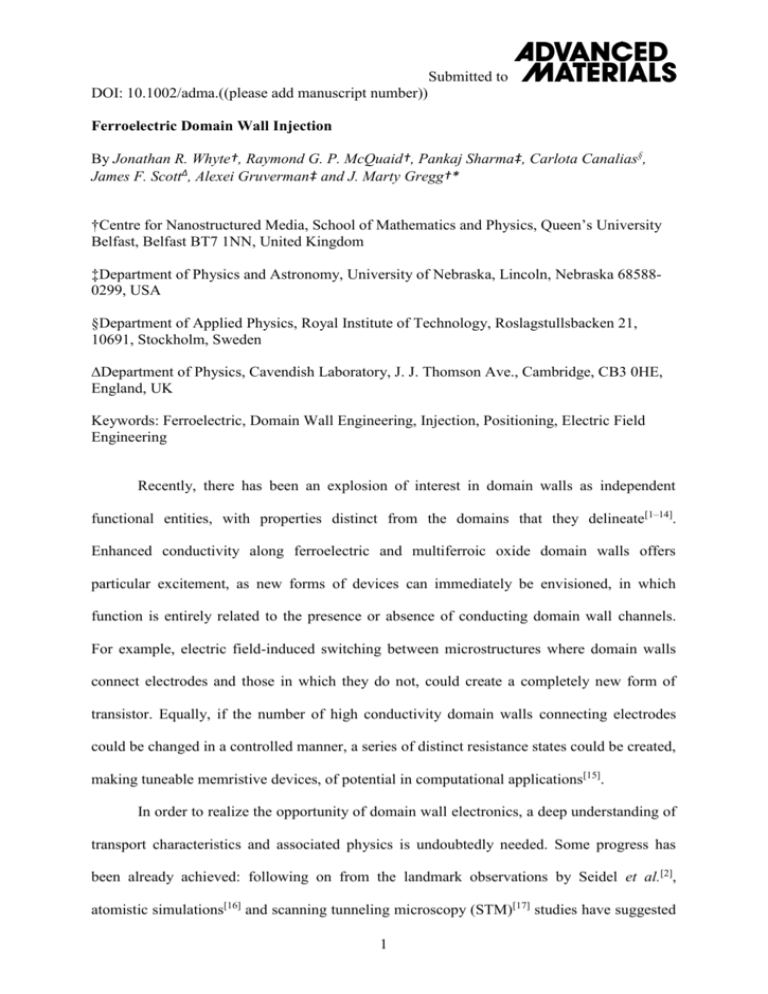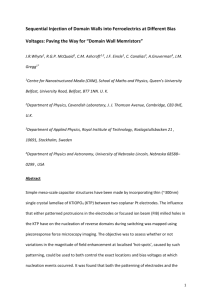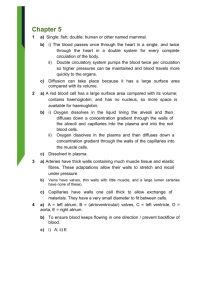Domain wall injection - Pure
advertisement

Submitted to DOI: 10.1002/adma.((please add manuscript number)) Ferroelectric Domain Wall Injection By Jonathan R. Whyte†, Raymond G. P. McQuaid†, Pankaj Sharma‡, Carlota Canalias§, James F. Scott∆, Alexei Gruverman‡ and J. Marty Gregg†* †Centre for Nanostructured Media, School of Mathematics and Physics, Queen’s University Belfast, Belfast BT7 1NN, United Kingdom ‡Department of Physics and Astronomy, University of Nebraska, Lincoln, Nebraska 685880299, USA §Department of Applied Physics, Royal Institute of Technology, Roslagstullsbacken 21, 10691, Stockholm, Sweden ∆Department of Physics, Cavendish Laboratory, J. J. Thomson Ave., Cambridge, CB3 0HE, England, UK Keywords: Ferroelectric, Domain Wall Engineering, Injection, Positioning, Electric Field Engineering Recently, there has been an explosion of interest in domain walls as independent functional entities, with properties distinct from the domains that they delineate[1–14]. Enhanced conductivity along ferroelectric and multiferroic oxide domain walls offers particular excitement, as new forms of devices can immediately be envisioned, in which function is entirely related to the presence or absence of conducting domain wall channels. For example, electric field-induced switching between microstructures where domain walls connect electrodes and those in which they do not, could create a completely new form of transistor. Equally, if the number of high conductivity domain walls connecting electrodes could be changed in a controlled manner, a series of distinct resistance states could be created, making tuneable memristive devices, of potential in computational applications[15]. In order to realize the opportunity of domain wall electronics, a deep understanding of transport characteristics and associated physics is undoubtedly needed. Some progress has been already achieved: following on from the landmark observations by Seidel et al.[2], atomistic simulations[16] and scanning tunneling microscopy (STM)[17] studies have suggested 1 Submitted to that conductivity results from fundamental alterations in the electronic band structure within the domain wall. Farokhipoor and Noheda[7] have established the important role of oxygen pressure during thin film growth. The importance of oxygen vacancies (known to preferentially aggregate at domain walls[18-20]) has therefore been established as a vehicle for creating defect-dopant electronic states. Domain wall conductivity in lead zirconate titanate (PZT) thin films has also been seen to be sensitive to oxygenation[21]. The other major factor associated with conductivity is the nominal charge state of the domain wall induced by opposing ‘head-to-head’ or ‘tail-to-tail’ polarization components, presumably due to an electrostatically driven accumulation of mobile screening point defects[9-11,22-23]. Schröder et al.[24] demonstrated that photoexcitation could also play a role in their discovery of domain wall conduction in millimeter thick single crystal lithium niobate (LiNbO3). While understanding charge transport is a major element in the realization of domain wall-based electronic devices, the other aspect of behavior that needs to be mastered is the precise control over where and when domain walls are injected into a system, and how their subsequent motion is determined. While this kind of capability has been already developed within the nanomagnetics field[25-32] it is still at its nascent stage in ferroelectric and multiferroic systems. Here, we demonstrate how domain wall behavior in uniaxial mesoscale ferroelectric capacitor structures can be controlled by manipulating the internal electric field landscape through fabrication of localized structural defects (air holes) of various size, shape and density. Specifically, we show that local field enhancement zones (the so-called ‘hot-spots’) adjacent to defects, patterned into the ferroelectric by focused ion beam milling (FIB), allow sitespecific domain nucleation and controllable movement of domain walls. Local regions with relatively low field intensity (cold-spots) were also found to inhibit domain wall propagation. Thin single-crystal lamellar slices (thickness ~300 nm) of the uniaxial ferroelectric KTiOPO4 (KTP)[33-34] with top and bottom surfaces parallel to (010)orthorhombic 2 (o), were Submitted to machined from a (001)o oriented periodically poled KTP bulk crystal, using focused ion beam (FIB) milling, and integrated as the dielectric layer into simple coplanar capacitor devices (see Methods Section). The form of a complete KTP capacitor structure, without any milled defects, is shown schematically in Fig. 1a. Figure 1b shows PFM amplitude and phase maps of the remanent domain states in the KTP lamella developing as a function of the potential difference applied between the two Pt electrodes. What is immediately apparent from this sequence of images is that, during the switching cycle, domains are nucleated sporadically and unpredictably. Presumably, at each nucleation site, there is some defect that lowers the energy barrier required for reverse domain nucleation. However, the important point is that such nucleation sites are neither well-controlled, nor could their position or critical voltage for occurrence have been predicted prior to switching. To exert control over the spatial location of nucleation sites we engineer heterogeneity in the developed electric field (as informed by finite element modeling) via FIB milled holes into the lamella. Through indirect hysteresis measurements, McQuaid et al.[35] and McMillen et al.,[36] rationalised measured changes in domain wall mobility by local enhancement or denudation of the electric field in BaTiO3 ferroelectric wires patterned with notches and antinotches. However, the precise way in which engineered electric field heterogeneity influences domain nucleation, and subsequent wall mobility, has not been explicitly visualized until now. Figure 2a illustrates the local field variations associated with circular holes cut into the KTP lamellae within the interelectrode gap, when a potential difference is applied to the capacitor electrodes. A scanning electron microscope (SEM) image of a real KTP capacitor sample with two sets of FIB-fabricated circular hole defects, reflecting those modeled in Fig. 2a, is shown in Fig. 2b. Modeling indicates that there is a dramatic field enhancement on either side of the holes, parallel to the electrodes, and associated field reduction above and 3 Submitted to below them, in regions closer to the electrodes, due to the relative distribution of high and low permittivity regions (KTP and air respectively). The KTP lamella originated in a monodomain state due to the bulk crystal being prepoled, shown in Fig. 2c. One second voltage pulses were then applied, in the opposite sense to the initial poling voltage (in steps of 10 V) and a PFM image of the whole lamella was captured between each pulse application. Reverse domains first appeared after the application of the 70V pulse (Fig. 2c). Importantly, the position in which the reverse domains nucleated correlated strongly with the position of the field hotspots as modeled in Fig. 2a, clearly suggesting that the increased field intensity adjacent to the FIB-machined holes was responsible for inducing the site-specific nucleation observed. To gain greater insight into the exact locations and critical voltages at which reverse domain nucleation (or initial injection of domain wall pairs) occurred, the slow scan axis of the PFM was disabled to allow a single lateral line just above the defects to be continually scanned. After poling the lamella back to the monodomain state, a series of switching voltage pulses of increasing magnitude (10V increments) was then applied during the PFM line scan acquisition. The form of the experiment is illustrated schematically in Fig. 3a. This methodology allowed the position of nucleation events to be mapped immediately after the application of each voltage pulse. Figure 3b shows the PFM amplitude signal from the single line scan and how the information on that line scan changes as voltage pulses of increasing magnitude were successively applied. The exact points at which voltage pulses were supplied can be seen in the image by the sporadic ‘white’ lines of noise, suspected to result from electrostatic interactions between the cantilever and electrodes during the application of the larger voltage pulses. Domain wall pairs (where each pair appears as a single dark line in the PFM amplitude image) first appeared after a 1 second 60V pulse had been applied (note that one of the domain wall pairs, successfully injected initially, later backswitched). Correlation between the 4 Submitted to domain nucleation sites and modeled local field hot-spots is illustrated in Fig. 3c. As can be seen, domain wall injection events occur exactly at the points at which hot-spots in field are predicted. Note also that these hot-spot related nucleation events occur at the expense of any other sporadic reverse domains of the kind seen in Fig. 1c. Alternative shape designs for FIB-milled holes (and associated variations in local field inhomogeneity) were then examined. One such design consisted of four right-angled triangles arranged in a square formation (Fig. 4). This was of particular interest, as field modeling suggested a notably strong local field enhancement adjacent to the most acute of the vertex angles of the triangular holes (Fig. 4a). If local field variations were genuinely responsible for inducing reverse domain creation, then in this structure the first nucleation events would be expected in-between the sharp vertices of the triangles. To test this prediction, voltage pulses of incrementally increasing amplitude were applied to the single-domain KTP lamella with triangular holes. Remnant domain states were imaged by lateral PFM after each pulse application. First, it was found that domain nucleation occurred at a lower voltage (50V) than that in KTP lamellae with the circular holes described above. Second, from Fig. 4b, which shows the domain growth after a 60V pulse, it is clear that nucleation events have been initiated adjacent to the most acute vertex of the triangular holes i.e. the point at which the highest local electric field was expected. It was also observed that this defect design pinned propagation of the domain wall through the center of the sample as larger voltage pulses were applied, thus preventing the needle domain from reaching one of the electrodes (Fig 4b). FIB-milled hole defects not only produce regions of enhanced field strength but also cause localized field reduction, or ‘cold-spots’. While ‘hot-spots’ have been seen to induce domain nucleation, it was expected that cold-spots could significantly impede domain wall propagation. This expectation was tested by monitoring the motion of domain walls under an applied planar electric field using in-situ PFM[37] imaging in a KTP lamellar capacitor 5 Submitted to structure with two pairs of FIB-milled triangular holes (Fig. 5). The modeled electric field distribution for this pattern under an applied bias is shown in Fig. 5a. After application of a 5 second 110V pulse, the regions above and below each defect remained unswitched. These unswitched domains resided in the cold-spot regions of the lamella (Fig. 5b) showing very clear correlation with the field models. Again the slow scan axis was disabled and a single line on the lamella was continually scanned by the PFM. The scan line was situated just below one of the triangular defects and across the two domain walls of an unswitched domain, shown by the highlighted region in Fig. 5b. As the scan progressed with time, DC voltage was applied in the reverse direction to grow this domain. Several image lines were obtained before the applied voltage value was increased in 1V increments, allowing the movement of the domain walls to be monitored. Figure 5c shows the amplitude signal acquired from the single line PFM scan. As the scan progresses (top of image to bottom) the in-situ applied voltages increased from 11V to 22V. The domain wall on the right hand side can be seen to freely propagate further right under applied bias. In contrast, the domain wall on the left-hand side of the image remained almost stationary. The average distance moved by each domain wall at each voltage is shown in Fig. 5d. Comparison of the position of the domain walls and the modeled electric field landscapes shown in Fig. 5e, suggests that the right domain wall in Fig. 5c is close to a region where it should experience a significantly larger electric field than the left hand wall. Any subsequent movement of the right hand wall further to the right takes it past the local hotspot, but beyond that the field level experienced is still relatively high. For the left domain wall a very significant lateral movement would be required for it to reach a region of comparable field intensity. Overlayed on Fig. 5e are the spatial extents of the domain walls’ motions. Clearly, the left hand domain wall has remained pinned in a region of field denudation, while 6 Submitted to the right hand domain wall has experienced reasonable fields over the entire course of its propagation. From all of the above discussions, it is clear that the introduction of the low permittivity defects into KTP lamellae dramatically alters the domain switching dynamics. The manner in which switching behavior is altered is driven by heterogeneities in the local electric field related to the fabricated defects: domain walls are predictably injected into the lamellae at defect-determined locations that correlate with areas of local field enhancement. In addition, propagation and pinning of the domain walls strongly depend on the local field distribution defined by the shape and mutual arrangement of the fabricated defects. These observations highlight that the design of field heterogeneity could represent an important tool for manipulating the injection, position and movement of domain walls in any future ‘domain wall electronics’ - based devices. Experimental Sample preparation. Thin single-crystal KTP lamellar slices (thickness ~300 nm) were machined using a single beam FEI200TEM FIB, from a periodically poled KTP bulk crystal fabricated by Canalias. A micromanipulator-controlled fine glass needle was used to remove the lamellae from the bulk crystal and position it across a 2 µm interelectrode gap of a (sputter-coated) platinised passive MgO substrate with a pre FIB-milled electrode design similar to that of McQuaid et al. [38]. Defect pattern files were created in CleWin3 and imported into NanoBuilder on a FEI Nova 600 DualBeam system for automated milling of holes. Samples were then annealed in air at 300oC - 400oC for 6 hours for lamellae with or without defects respectively, to expel gallium ion contamination [39] whilst minimising chemical alterations of the KTP [40]. The gallium oxide residing on lamellar surfaces was removed via 3 minutes of etching in 3 M HCl solution, resulting in a high quality surface topography suitable for PFM domain imaging. Using electron-beam-induced-deposition of 7 Submitted to platinum on the same dual beam system, the lamellae were secured in place on each edge parallel to the interelectrode gap. The electron beam dissociates a precursor gas (MeCpPtMe3) to deposit platinum at the electron beam target whilst residual fragments are expelled from the vacuum chamber. Finally each electrode of the sample was conductively secured with silver paste onto a glass slide with macroscopically patterned sputter-coated platinum electrodes, enabling application of voltage across the sample whilst being positioned under an Atomic Force Microscope scanner head. Field modelling. Modeling of the local field distribution between the coplanar electrodes of the capacitor structures was performed using the ‘QuickField Finite Elements Analysis System’. Low frequency dielectric properties of KTP, found by Bierlein and Arweiler [41], were used as material parameter inputs for these finite element models. PFM domain imaging. PFM measurements were obtained from both Queen’s University Belfast (QUB) and the University of Nebraska – Lincoln (UNL). PFM measurements displayed in Fig. 1 were carried out in QUB whilst the remaining images were obtained from UNL. A Veeco Dimension 3100 AFM system with a Nanoscope IIIa controller, modified for PFM measurements using a EG&G 7265 lock-in-amplifier, was used in QUB. Here an oscillating voltage of 1 VRMS at a frequency of 20 kHz was applied to a Nanosensors PPPEFM cantilever (force constant ~2.8 N/m). The system used at UNL was a commercial Asylum Research MFP-3D system operated in single frequency PFM mode. MikroMasch DPE 18 cantilevers with an oscillating amplitude of 2 VPP at a frequency of 39 kHz from an Agilent Technologies 33220A Function/Arbitraty Waveform Generator were used in this case. DC voltages were applied to lamellae using a Keithley 237 High Voltage Source Measure Unit. In pulsed experiments, pulses applied were of 1 second duration. 8 Submitted to Acknowledgements The authors thank J. F. Einsle for helpful insight into creating high quality defect patterns in lamellae. In addition, the authors acknowledge financial support from the Materials World Network (MWN) scheme involving the Engineering and Physical Sciences Research Council in the UK (EP/H047093/1) and the National Science Foundation in the USA (DMR-1007943). International networking support from The Leverhulme Trust (F/00 203/V) is gratefully acknowledged. JMG, RGPMcQ and JRW acknowledge support from the Department of Employment and Learning (DEL). Received: ((will be filled in by the editorial staff)) Revised: ((will be filled in by the editorial staff)) Published online: ((will be filled in by the editorial staff)) References 1. A. Aird, E. K. H. Salje,. Sheet superconductivity in twin walls: experimental evidence of WO3-x. J.Phys.:Condens. Matter 1998, 10, L377–L380. 2. J. Seidel, L.W. Martin, Q. He, Q. Zhan, Y.-H. Chu, A. Rother, M. E. Hawkridge, P. Maksymovych, P. Yu, M. Gajek, N. Balke, S. V. Kalinin, S. Gemming, F. Wang, G. Catalan, J. F. Scott, N. A. Spaldin, J. Orenstein, and R. Ramesh, Conduction at domain walls in oxide multiferroics. Nat. Mater 2009, 8, 229–234. 3. E. K. H. Salje, Multiferroic Domain Boundaries as Active Memory Devices: Trajectories Towards Domain Boundary Engineering. ChemPhysChem 2010, 11, 940–950. 4. J. Guyonnet, I. Gaponenko, S. Gariglio, P. Paruch, Conduction at Domain Walls in Insulating Pb(Zr0.2Ti0.8)O3 Thin Films. Adv. Mater. 2011, 23, 5377–5382. 5. Y. Kaneko, Y. Nishitani, H. Tanaka, M. Ueda, Y. Kato, E. Tokumitsu, E. Fujii, Correlated Motion Dynamics of Electron Channels and Domain Walls in a Ferroelectricgate Thin-film Transistor Consisting of a ZnO/Pb(Zr,Ti)O3 Stacked Structure. J. Appl. Phys. 2011, 110, 084106–084106. 6. Y. Du, X. Wang, D. Chen, S. Dou, Z. Cheng, M. Higgins, G. Wallace, J. Wang, Domain Wall Conductivity in Oxygen Deficient Multiferroic YMnO3 Single Crystals. Appl. Phys. Lett. 2011, 99, 252107–252107. 7. S. Farokhipoor, B. Noheda, Conduction Through 71° Domain Walls in BiFeO3 Thin Films. Phys. Rev. Lett. 2011, 107, 127601. 8. P. Maksymovych, J. Seidel, Y. H. Chu, P. Wu, A. P. Baddorf, L. Q. Chen, S. V. Kalinin, R. Ramesh, Dynamic Conductivity of Ferroelectric Domain Walls in BiFeO3. Nano Lett. 9 Submitted to 2011, 11, 1906-1912. 9. D. Meier, J. Seidel, A. Cano, K. Delaney, Y. Kumagai, M. Mostovoy, N. A. Spaldin, R. Ramesh, M. Fiebig, Anisotropic Conductance at Improper Ferroelectric Domain Walls. Nat. Mater. 2012, 11, 284–288. 10. E. A. Eliseev, A. N. Morozovska, G. S. Svechnikov, P. Maksymovych, S. V. Kalinin, Domain Wall Conduction in Multiaxial Ferroelectrics. Phys. Rev. B 2012, 85, 045312. 11. A. N. Morozovska, R. K. Vasudevan, P. Maksymovych, S. V. Kalinin, E. A. Eliseev, Anisotropic Conductivity of Uncharged Domain Walls in BiFeO3. Phys. Rev. B 2012, 86, 085315. 12. P. Maksymovych, A. Morozovska, P. Yu, E. Eliseev, Y. H. Chu, R. Ramesh, A. Baddorf, S. Kalinin, Tunable Metallic Conductivity in Ferroelectric Nanodomains. Nano Lett. 2012, 12, 209–213. 13. W. Wu, Y. Horibe, N. Lee, S. W. Cheong, J. Guest, Conduction of Topologically Protected Charged Ferroelectric Domain Walls. Phys. Rev. Lett. 2012, 108, 77203. 14. S. Van Aert, S. Turner, R. Delville, D. Schryvers, G. V. Tendeloo, E. K. H. Salje, Direct Observation of Ferrielectricity at Ferroelastic Domain Boundaries in CaTiO3 by Electron Microscopy. Adv. Mater. 2012, 24, 523-527. 15. J. J. Yang, D. B. Strukov, D. R. Stewart, Memristive Devices for Computing. Nat. Nanotechnol. 2012, 8, 13–24. 16. A. Lubk, S. Gemming, N. Spaldin, First-principles Study of Ferroelectric Domain Walls in Multiferroic Bismuth Ferrite. Phys. Rev. B 2009, 80, 104110. 17. Y. P. Chiu, Y. T. Chen, B. C. Huang, M. C. Shih, J. C. Yang, Q. He, C. W. Liang, J. Seidel, Y. C. Chen, R. Ramesh, Y. H. Chu, Atomic-Scale Evolution of Local Electronic Structure Across Multiferroic Domain Walls. Adv. Mater. 2011, 23, 1530–1534. 18. Z. Wen, Y. Lv, D. Wu, A. Li, Polarization Fatigue of Pr and Mn Co-substituted BiFeO3 Thin Films. Appl. Phys. Lett. 2011, 99, 012903. 19. L. Hong, A. Soh, Q. Du, J. Li, Interaction of O Vacancies and Domain Structures in Single Crystal BaTiO3: Two-dimensional Ferroelectric Model. Phys. Rev. B 2008, 77, 094104. 20. L. He, D. Vanderbilt, First-principles Study of Oxygen-vacancy Pinning of Domain Walls in PbTiO3. Phys. Rev. B 2003, 68, 134103. 21. Paruch, P. Private Communication. 22. T. Sluka, A. K. Tagantsev, D. Damjanovic, M. Gureev, N. Setter, Enhanced Electromechanical Response of Ferroelectrics Due to Charged Domain Walls. Nat. Commun. 2012, 3, 748. 10 Submitted to 23. T.Sluka, A. K. Tagantsev, P. Bednyakov, N. Setter, Free-electron gas at charged domain walls in insulating BaTiO3. Nat. Commun. 2013, 4, 1808. 24. M. Schrӧder, A. Haußmann, A. Thiessen, E. Soergel, T. Woike, L. M. Eng, Conducting Domain Walls in Lithium Niobate Single Crystals. Adv. Funct. Mater. 2012, 22, 3936– 3944. 25. D. Allwood, G. Xiong, C. Faulkner, D. Atkinson, D. Petit, R. Cowburn, Magnetic Domain-wall Logic. Science 2005, 309, 1688–1692. 26. S. S. P. Parkin , M. Hayashi, L. Thomas, Magnetic domain-wall racetrack memory. Science 2008, 320, 190–194. 27. D. Allwood, G. Xiong, M. Cooke, C. Faulkner, D. Atkinson, N. Vernier, R. Cowburn, Submicrometer Ferromagnetic NOT Gate and Shift Register. Science 2002, 296, 2003– 2006. 28. D. Allwood, G. Xiong, R. Cowburn, Writing and Erasing Data in Magnetic Domain Wall Logic Systems. Journal of applied physics 2006, 100, 123908–123908. 29. D. Allwood, G. Xiong, R. Cowburn, Magnetic Domain Wall Serial-in Parallel-out Shift Register. Applied physics letters 2006, 89, 102504. 30. R. Cowburn, D. Allwood, G. Xiong, M. Cooke, Domain Wall Injection and Propagation in Planar Permalloy Nanowires. J. Appl. Phys. 2002, 91, 6949. 31. D. Atkinson, D. Allwood, G. Xiong, M. D. Cooke, C. C. Faulkner, R. P. Cowburn, Magnetic Domain-wall Dynamics in a Submicrometre Ferromagnetic Structure. Nat. Mater. 2003, 2, 85–87. 32. M. Hayashi, L. Thomas, Y. B. Bazaliy, C. Rettner, R. Moriya, X. Jiang, S. Parkin, Influence of Current on Field-driven Domain Wall Motion in Permalloy Nanowires from Time Resolved Measurements of Anisotropic Magnetoresistance. Phys. Rev. Lett. 2006, 96, 197207. 33. J. C. Toledano, Ferroelasticity. Annals of Telecommunications 1974, 29, 249–270 34. P. I. Tordjman, E. Masse, J. Guitel, Crystalline Structure of Monophosphate KTIPO5. Z. Kristallogr. 1974, 139, 103–115. 35. R. G. P. McQuaid, L. W. Chang, J. M. Gregg, The Effect of Antinotches on Domain Wall Mobility in Single Crystal Ferroelectric Nanowires. Nano Lett. 2010, 10, 3566–3571. 36. M. McMillen, R. G. P. McQuaid, S. Haire, C. McLaughlin, L. W. Chang, A. Schilling, J. M. Gregg, The Influence of Notches on Domain Dynamics in Ferroelectric Nanowires. Appl. Phys. Lett. 2010, 96, 042904. 37. P. Sharma, R. G. P. McQuaid, L. J. McGilly, J. M. Gregg, A. Gruverman, Nanoscale Dynamics of Superdomain Boundaries in Single-Crystal BaTiO3 Lamellae. Adv. Mater. 2013, 25, 1323-1330 11 Submitted to 38. R. G. P. McQuaid, L. J. McGilly, P. Sharma, A. Gruverman, J. M. Gregg, Mesoscale Flux-closure Domain Formation in Single-crystal BaTiO3. Nat. Commun. 2011, 2, 404. 39. A. Schilling, T. Adams, R. Bowman, J. M. Gregg, Strategies for Gallium Removal After Focused Ion Beam Patterning of Ferroelectric Oxide Nanostructures. Nanotechnology 2007, 18, 035301. 40. V. Atuchin, N. Y. Maklakova, L. Pokrovsky, V. Semenenko, Restoration of KTiOPO4 Surface by Annealing. Opt. Mater. 2003, 23, 363–367. 41. J. Bierlein, C. Arweiler, Electro-optic and Dielectric Properties of KTiOPO4. Appl. Phys. Lett. 1986, 49, 917–919. 12 Submitted to Figure 1: Experimental setup and sporadic nature of switching in unpatterned KTP lamella. (a) 3D schematic of experimental setup showing the lamella placed across a 2µm gap between Pt electrodes, with <001>o axis perpendicular to the interelectrode gap edge and <100>o parallel to it; the lamella is secured in position with electron beam deposited platinum. The PFM cantilever tip scans across the surface yielding domain images. (b) Lateral PFM amplitude (left) and phase (right) images of remnant domain states after the application of voltage pulses of various amplitude and polarity; domain nucleation events across the lamella are random. 13 Submitted to Figure 2: Domain nucleation in KTP lamellae with patterned circles. (a) Electric field model of KTP lamella with milled circles under 60V applied between coplanar electrodes (top and bottom) showing the creation of field hot-spots left and right of the defects and cold-spots above and below. (b) SEM image of a KTP lamella with milled circular defects (c) PFM images of amplitude (left) and phase signals (right) showing a mono-domain state from 0-60V (top) and domain nucleations aligned with the field hot-spots post application of 70V (bottom) (white circles superimposed to show positions of holes). 14 Submitted to Figure 3: Domain wall injection through defect-induced generation of the local field hotspots. (a) Schematic of experimental setup with red highlighted region showing the position of the scan line. (b) Amplitude image showing the observation of new domain wall pairs which appear to be in line with the field hot-spots shown in Figure 2a. (c) PFM amplitude profile showing domain walls (minima in amplitude) with corresponding modeled E-field values showing that the positions of nucleated domain walls coincide with the location of field hotspots. 15 Submitted to Figure 4: Single nucleation event from field hot-spots near triangular defects. (a) Electric field model of KTP lamella under the application of 100 V with field hotspots positioned at inside vertices of triangular holes. (b) Amplitude (left) and phase (right) images show the appearance of a new domain nucleating from one of the hot-spots post application of 60 V, implying that the production of field hotspots can control the exact location of reverse domain nucleation. 16 Submitted to Figure 5: Effect of local field inhomogeneity on domain wall movement. (a) Electric field model of triangular defects. (b) Phase information of the remnant domain state post application of 5 second 110V pulse and with the phase information overlaid on sample topography; a schematic of the cantilever tip continually scanning one line (in red) whilst field is applied is also shown. (c) Amplitude PFM image of the red line in (b) showing the difference in the propagation of the two domain walls as voltage is increased. (d) The magnitude of the left and right domain walls’ displacement from their original position as a function of voltage applied. The displacement was calculated using the average domain 17 Submitted to wall position at each voltage. (e) The modeled local field values of scan position with the relative movements of the domain walls showing that the extent of domain wall movement is directly correlated with the field intensities experienced during propagation. 18









